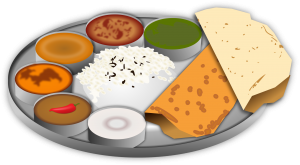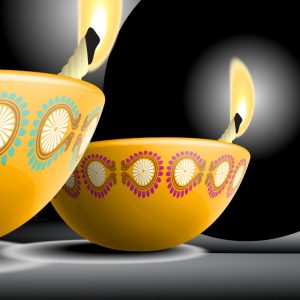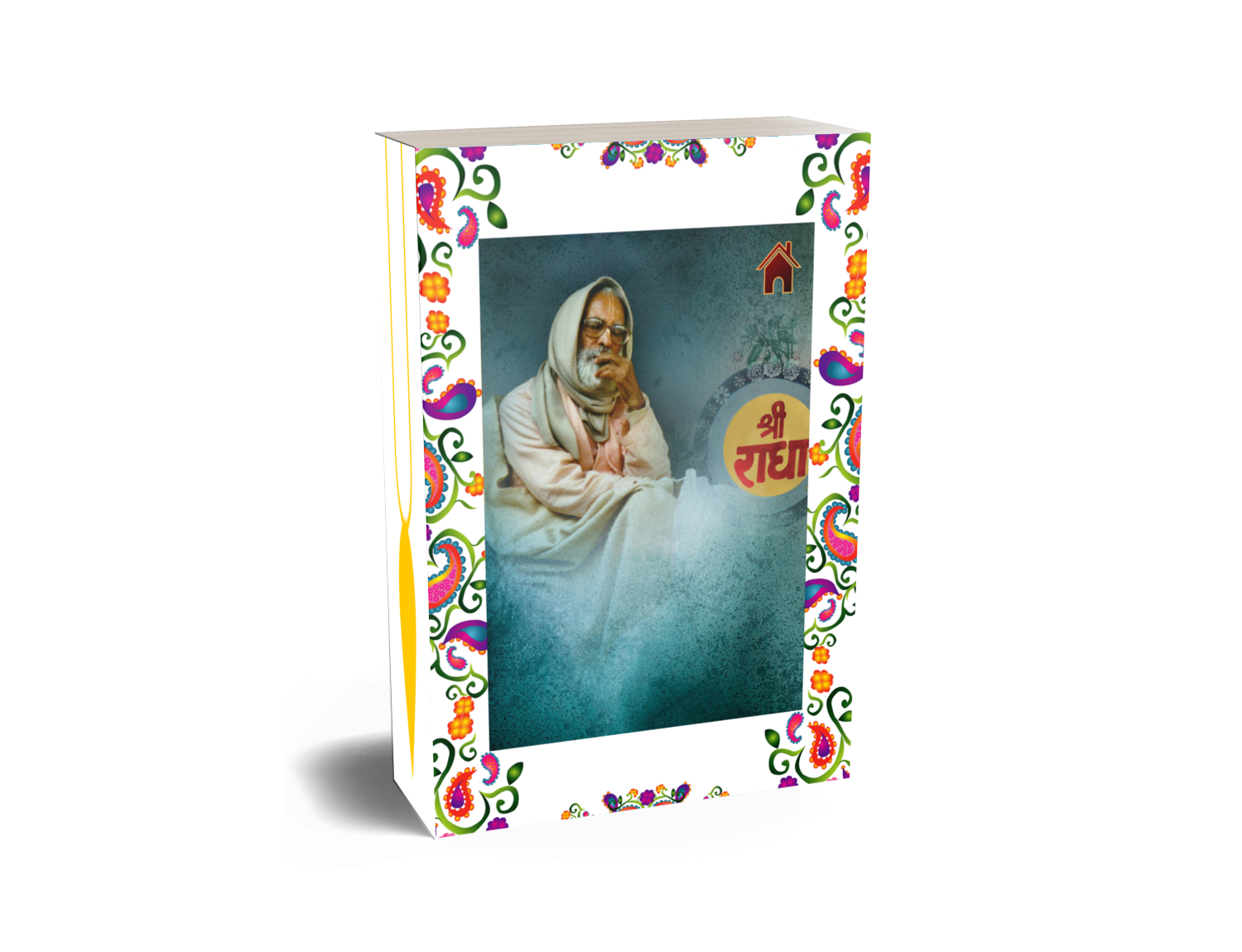

Excerpt from the book Ācārya Kesarī Śrī Śrīmad Bhakti Prajñāna Keśava Gosvāmī – His Life and Teachings, 2nd Edition by Śrīla Bhaktivedānta Nārāyaṇa Mahārāja
On one occasion, a new tridaṇḍī-sannyāsī arrived to take Bābājī’s [Śrīla Vaṁśīdāsa Bābājī Mahārāja’s] darśana.  Seeing him offering his praṇāma, Bābājī said, “Fresh bamboo wrapped in cloth does not constitute a daṇḍa, and one does not become a tridaṇḍī by holding it. The significance of carrying a tridaṇḍa is to utilize the body, mind and words completely in the service of Bhagavān.” The new sannyāsī was very simple and could extract the essence of the instruction. He became very happy when he heard Bābājī’s words and said: “Ki kāj sannyāse, mora prema–prayojana, dāsa kari’ vetana mora deha premadhana – What is the need of my sannyāsa? My goal is to achieve prema. Please make me your servant and give me the wealth of prema as my salary.”
Seeing him offering his praṇāma, Bābājī said, “Fresh bamboo wrapped in cloth does not constitute a daṇḍa, and one does not become a tridaṇḍī by holding it. The significance of carrying a tridaṇḍa is to utilize the body, mind and words completely in the service of Bhagavān.” The new sannyāsī was very simple and could extract the essence of the instruction. He became very happy when he heard Bābājī’s words and said: “Ki kāj sannyāse, mora prema–prayojana, dāsa kari’ vetana mora deha premadhana – What is the need of my sannyāsa? My goal is to achieve prema. Please make me your servant and give me the wealth of prema as my salary.”

The following is an excerpt from Śrīla Bhaktivedānta Nārāyaṇa Mahārāja’s commentary in the form of a chapter-endnote on Jaiva-dharma
Śrīla Bhaktivinoda Ṭhākura has stated that in the age of Kali it is recommended that all jīvas become gṛhastha 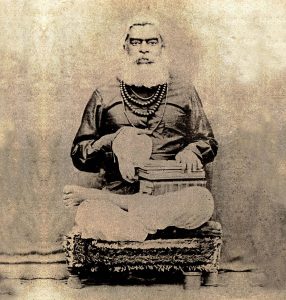 Vaiṣṇavas, for in this there is no fear of falling down. The meaning of this statement is that it is the duty of all human beings to live in an unfallen condition and engage in the service of Viṣṇu and Vaiṣṇavas. However, it is not the intention of the author to instruct that everyone must be a gṛhastha or that in the age of Kali no one should accept any āśrama other than the gṛhastha-āśrama. Those who are heavily influenced by the material qualities of passion and ignorance, who are excessively attached to material sense enjoyment, and who have a strong inclination toward the path of fruitive action (pravṛtti-mārga) are recommended to accept marriage and follow the gṛhastha-dharma in order to counteract these tendencies. On the other hand, those whose nature is of the quality of goodness and purity, and who follow the path of detachment (nivṛtti-mārga) should not marry and thus become fallen.
Vaiṣṇavas, for in this there is no fear of falling down. The meaning of this statement is that it is the duty of all human beings to live in an unfallen condition and engage in the service of Viṣṇu and Vaiṣṇavas. However, it is not the intention of the author to instruct that everyone must be a gṛhastha or that in the age of Kali no one should accept any āśrama other than the gṛhastha-āśrama. Those who are heavily influenced by the material qualities of passion and ignorance, who are excessively attached to material sense enjoyment, and who have a strong inclination toward the path of fruitive action (pravṛtti-mārga) are recommended to accept marriage and follow the gṛhastha-dharma in order to counteract these tendencies. On the other hand, those whose nature is of the quality of goodness and purity, and who follow the path of detachment (nivṛtti-mārga) should not marry and thus become fallen.
In the Viṣṇu Purāṇa (3.8.9) we find the following statement regarding āśrama:
varṇāśramācāravatā
puruṣeṇa paraḥ pumān
viṣṇur ārādhyate panthā
nānyat tat-toṣa-kāraṇam
Śrī Viṣṇu is worshipped only by carrying out one’s prescribed duties in varṇāśrama. There is no other way to please Him.
In this śloka, the word āśrama refers not only to the gṛhastha-āśrama, but to all four āśramas. In Śrīmad-Bhāgavatam (11.17.14) there is the following statement regarding āśrama:
gṛhāśramo jaghanato
brahmacaryaṁ hṛdo mama
vakṣaḥ-sthalād vane-vāsaḥ
sannyāsaḥ śirasi sthitaḥ
The gṛhastha-āśrama has sprung from the thighs of My universal form, the brahmacārī-āśrama from My heart, the vānaprastha- āśrama from My chest, and the sannyāsa-āśrama from My head.
These are the four āśramas described in the śāstra. One of the characteristics of a Vaiṣṇava is engaging in the worship of Śrī Viṣṇu while remaining in the āśrama for which he is eligible. At present there is no shortage of examples of this. In this very book, the characters, Prema dāsa, Vaiṣṇava dāsa, Ananta dāsa, and many other qualified instructors are sannyāsīs, brahmacārīs, or gṛha-tyāgīs.
Another point is that not all the followers of the author, Śrī Bhaktivinoda Ṭhākura, are gṛhastha-bhaktas. Some of them are brahmacārīs and some have given up household life, and are situated in the highest order, sannyāsa, and are thus fit to instruct the world. In the third chapter, sannyāsa is referred to as the topmost āśrama. This same conclusion is expressed in Śrīmad-Bhāgavatam (11.17.15), the crest-jewel of all śāstras:
varṇānām āśramāṇāṁ ca
janma-bhūmy-anusāriṇīḥ
āsan prakṛtayo nṝnāṁ
nīcair nīcottamottamāḥ
The varṇas and āśramas of humanity are possessed of higher and lower natures in accordance with the higher and lower places on Śrī Bhagavān’s universal body from which they appeared.
The conclusion of this statement is that sannyāsa is the highest of the four āśramas, and gṛhastha is the lowest. The brahmacārī-āśrama is situated above the gṛhastha-āśrama, and the vānaprastha-āśrama is situated above the brahmacārī-āśrama. These āśramas are related to the acquired tendency arising from one’s temporary nature.
Like varṇas, āśramas are also divided according to nature, tendency, and work. Men of lower nature, who are inclined to engage in fruitive action, are compelled to become gṛhasthas. Naiṣṭhika-brahmacārīs, those who adopt a life-long vow of celibacy, are the wealth of Śrī Kṛṣṇa’s heart. Vānaprastha renunciants have appeared from Kṛṣṇa’s chest, and sannyāsīs, who are the reservoirs of auspicious qualities, have arisen from His head. The brahmacārīs, vānaprasthas, and sannyāsīs are therefore all superior to the gṛhasthas, but one remains ineligible to enter into these three superior āśramas as long as a taste for the path of renunciation is not awakened in the heart. In the Manu-saṁhitā (5.56) it is said:
na māṁsa-bhakṣaṇe doṣo
na madye na ca maithune
pravṛttir eṣā bhūtānāṁ
nivṛttis tu mahā-phalā
Human beings are naturally inclined to the pleasures of meat-eating, intoxication, and sexual indulgence, but abstinence from such activities yields highly beneficial results.
This is corroborated in the Śrīmad-Bhāgavatam (11.5.11):
loke vyavāyāmiṣa-madya-sevā
nityā hi jantor na hi tatra codanā
vyavasthitis teṣu vivāha-yajña
surā-grahair āsu nivṛttir iṣṭā
In this world it is observed that people have a natural tendency toward sexual enjoyment, meat-eating, and  intoxication. Śāstra cannot sanction engagement in such activities, but special provisions have been given whereby some association with the opposite sex is permitted through marriage; some eating of flesh is permitted through the performance of sacrifice; the drinking of wine is permitted in the ritual known as sautrāmaṇī-yajña. The purpose of such injunctions is to restrain the licentious tendencies of the general populace and to establish them in moral conduct.
intoxication. Śāstra cannot sanction engagement in such activities, but special provisions have been given whereby some association with the opposite sex is permitted through marriage; some eating of flesh is permitted through the performance of sacrifice; the drinking of wine is permitted in the ritual known as sautrāmaṇī-yajña. The purpose of such injunctions is to restrain the licentious tendencies of the general populace and to establish them in moral conduct.
The intrinsic purpose of the Vedas in making such provisions is to draw people away from such activities altogether.
In many other śāstras the superiority of the path of renunciation has been delineated. At the end of the tenth chapter of this book, Śrī Bhaktivinoda Ṭhākura has cited the above-mentioned Bhāgavatam śloka, and drawn the following conclusion: “It is not the purpose of śāstra to encourage the killing of animals. The Vedas state, mā himsyāt sarvāṇi bhūtāni: “Do not harm any living entity.’ This statement forbids violence against animals. However, as long as a person’s nature is strongly influenced by passion and ignorance, he will have a natural  inclination toward sexual enjoyment, meat-eating, and intoxication. Such a person does not await the sanction of the Vedas to engage in such activities. The intent of the Vedas is to provide a means whereby human beings who have not adopted the quality of goodness – and thus renounced the tendency for violence, sexual enjoyment, and intoxication – can curb such tendencies and satisfy these demands through the agency of religion.
inclination toward sexual enjoyment, meat-eating, and intoxication. Such a person does not await the sanction of the Vedas to engage in such activities. The intent of the Vedas is to provide a means whereby human beings who have not adopted the quality of goodness – and thus renounced the tendency for violence, sexual enjoyment, and intoxication – can curb such tendencies and satisfy these demands through the agency of religion.
“People who are conducted by these lower tendencies may associate with the opposite sex through religious marriage; they may kill animals only through certain prescribed methods of sacrifice; they may take intoxication only on certain occasions, and by following certain procedures. By following these methods their tendency toward these activities will wane and they will gradually give them up.”
Therefore, the gṛhastha-āśrama is necessary in Kali-yuga in order to draw people away from the path of fruitive action and toward the path of renunciation. It was never the intention of the author to suggest that those who are eligible for the highest order of life should become gṛhasthas. Later in this same chapter, Śrī Bhaktivinoda Ṭhākura has expressed the purpose of marriage in the following words:
“One should not enter marriage for the purpose of begetting children or to worship the forefathers. Rather, one should think, ‘I accept this maidservant of Kṛṣṇa so that we may be able to assist each other in the service of Kṛṣṇa.’ This attitude is favourable to bhakti.”
Consequently, those who marry without a desire for children can actually be true gṛhastha Vaiṣṇavas. When a man truly regards his wife as a maidservant of Kṛṣṇa, there is no scope for regarding her as an object of his own pleasure; instead his mood will be one of adoration. It is a fact that there are statements that sanction the desire for children, such as putrārthe kriyate bhāryā: “A wife is accepted for the purpose of having children,” but the implication here is that one should desire to beget servants of Kṛṣṇa, and not ordinary mundane children.
The word putra (son) is derived from the word put, which refers to a particular hellish planet, and tra is derived from the verbal root meaning ‘to deliver’. Thus the traditional significance of the word putra is to beget a son who can deliver one from hell by offering oblations after one’s demise. However, there is no possibility that Vaiṣṇavas who regularly chant śrī-hari-nāma will go to the hell known as put. Therefore they do not desire putras, but servants of Kṛṣṇa.
Generally, a man who is bound by material conditioning, and who pursues the path of fruitive action, indulges  in sexual intercourse with a woman in order to satisfy his lusty propensities. Children are born only as a by-product of that desire. This is the reason why people these days are generally of a lustful nature. As it is commonly said, “ātmavat jāyate putraḥ – A son takes after his father.”
in sexual intercourse with a woman in order to satisfy his lusty propensities. Children are born only as a by-product of that desire. This is the reason why people these days are generally of a lustful nature. As it is commonly said, “ātmavat jāyate putraḥ – A son takes after his father.”
Although the gṛhastha-āśrama is the lowest of the four āśramas, Śrīla Bhaktivinoda Ṭhākura has recommended it with a desire to benefit everyone in the world. His recommendation is especially directed toward people whose mentality is similar to that of Caṇḍīdāsa and Damayantī. Actually, great souls who naturally follow the path of detachment by the influence of the sukṛti they have acquired in previous lives will never become entangled in domestic life by accepting marriage. Such elevated people still have the opportunity to fall, but where is the question of falling for people who are already fallen?
If a naiṣṭhika-brahmacārī or a sannyāsī were to misunderstand the underlying meaning of the above-mentioned instruction, and on the basis of those words were to give up their brahmacarya or sannyāsa and, in contravention to śāstra, marry one of their disciples, a god-sister or some other woman, or were to advise another brahmacārī or sannyāsī to do so, then such a(n) pitiable, base and atheistic person would indeed be rare in the history of the world.
A second point is that it is highly disgraceful for unqualified people to adopt the dress of brahmacārīs, tyāgīs or sannyāsīs, to imitate their behaviour, and to consider themselves equal to great personalities situated in those āśramas. Such people are like Śṛgāla Vāsudeva, the jackal who impersonated Śrī Kṛṣṇa, and whose narration has been described in Śrīmad-Bhāgavatam, Harivaṁśa, Caitanya-Bhāgavata, and other śāstras. People who are situated in a lower stage, and who are attached to the path of fruitive action, should first curb the deplorable tendency towards lust by becoming lawfully married according to religious principles. The purpose of the śāstra is to guide all living beings toward the path of detachment.
The Brahma-vaivarta Purāṇa (Kṛṣṇa-khaṇḍa 115.112–113) states:
aśvamedhaṁ gavālambhaṁ
sannyāsaṁ pala-paitṛkam
devareṇa sutotpattiṁ
kalau pañca vivarjayet
In Kali-yuga five activities are forbidden: the offering of a horse in sacrifice, the offering of a cow in sacrifice, the acceptance of sannyāsa, offering flesh to the forefathers, and begetting children through a husband’s brother.
Some people try to establish on the basis of this śloka that the acceptance of sannyāsa is forbidden in Kali-yuga. However, this śloka has a hidden intention. The purpose of this śloka is not to forbid sannyāsa altogether. Indeed, many great personalities who appeared in Kali-yuga were tyāgīs or sannyāsīs, including Śrī Rāmānuja, Śrī Madhva, Śrī Viṣṇusvāmī, and other ācāryas who were well acquainted with all the śāstras, as well as the  crown jewels of all ācāryas, the Six Gosvāmīs, who were bhaktas of Śrī Gaura.
crown jewels of all ācāryas, the Six Gosvāmīs, who were bhaktas of Śrī Gaura.
The pure succession of sannyāsa is continuing, even today. The injunction against accepting sannyāsa in Kali-yuga actually means that it is improper to accept the ekadaṇḍa-sannyāsa that evolved from the unauthorized line of thought propagated by Ācārya Śaṅkara, and which is expressed in maxims such as so ‘haṁ (I am that brahma) and ahaṁ brahmāsmi (I am brahma). It is this type of sannyāsa that has been forbidden.
Tridaṇḍa-sannyāsa is the real, perpetual sannyāsa, and it is applicable at all times. Sometimes tridaṇḍa-sannyāsa externally appears in the form of ekadaṇḍa-sannyāsa. Ekadaṇḍa-sannyāsīs of this type, who are actually great souls, accept the eternality of tridaṇḍa-sannyāsa that symbolizes the three features of sevya (the object of service), sevaka (the servitor), and sevā (service). Such people consider the ekadaṇḍa-sannyāsa propagated by Śaṅkara to be completely unauthorized and not supported by śāstra. It is therefore proven, even on the basis of the Brahma-vaivarta Purāṇa śloka cited by smārta ācāryas, that it is logical for sādhakas who are pursuing the nivṛtti-mārga to accept sannyāsa.

Excerpt from the book Prabandha-pañcakam – Five Essential Essays, by Śrīla Bhaktivedānta Nārāyaṇa Mahārāja
The varṇāśrama social order is the backbone of Indian sanskṛti or sanātana dharma and its heart is bhagavata-prema. The relationship between the varṇāśrama-system and bhagavata-prema is the same as the relationship between the body and the ātmā. Although the ātmā is of primary importance, the body is not to be entirely neglected in the conditioned stage. Similarly varṇāśrama-dharma is not to be completely neglected while in the conditioned stage of life. However it is not correct to propose that varṇāśrama-dharma is the ultimate word in dharma. On becoming situated in ātmā-dharma, that is bhagavata-sevā, the aim and object of varṇāśrama are fulfilled. Only in that stage is it possible to be completely indifferent to varṇāśrama-dharma and remain absorbed in unalloyed bhagavata-bhajana. Wherever there is no varṇāśrama-system we also see a lack of ātmā-dharma or pure bhagavata-bhakti. At the most we see a semblance or perverted reflection of bhakti. Therefore respect for daiva-varṇāśrama is evident in all the sampradāyas of dharma in India. The practitioner of bhakti can remain in whichever āśrama is favourable for his sādhana-bhajana or, when he is qualified, he can completely renounce varṇāśrama. It should be especially noted that the regulations of varṇāśrama have no control over those who are beyond anartha-nivṛtti and in whom bhāva has made its appearance. As long as such a stage is not attained, it is desirable for Śrī Gauḍīya Vaiṣṇavas in the line of Śrīman Mahāprabhu to externally accept varṇāśrama while remaining detached and keeping the false ego of identifying oneself with it far away. (Chapter One)
From where has this word ‘bābājīi’ come in our line? From whom has it come? Īśvara Purīpāda, Mādhavendra Purīpāda, Śrī Caitanya Mahāprabhu, Nityānanda Prabhu, and after Him, Śrī Rūpa Gosvāmī, Śrī Sanātana Gosvāmī, Śrīla Raghunātha Bhaṭṭa Gosvāmī, Śrī Jīva Gosvāmī, Śrī Gopāla Bhaṭṭa Gosvāmī, and Śrī Raghunātha dāsa Gosvāmī. After them, Kṛṣṇa dāsa Kavirāja Gosvāmī and Vṛndāvana dāsa Ṭhākura, and then Narottama dāsa Ṭhākura, Śyāmānanda dāsa, Śrīnivāsa Ācārya, and Viśvanātha Cakravartī Ṭhākura. Where is the word bābājī? Was anyone known as Bābājī? From where did this word bābājī come? The bābājīs have no 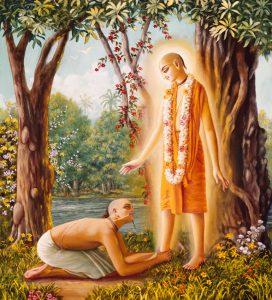 reply. These Vaiṣṇavas were all paramahaṁsas, not bābājīs.
reply. These Vaiṣṇavas were all paramahaṁsas, not bābājīs.
Śrī Sanātana Gosvāmī did not wear saffron cloth because he had great honour for Śrī Caitanya Mahāprabhu’s saffron or reddish cloth. He was thinking, “I cannot be like Him, I am not so high.” Therefore, out of honour and reverence he wore white cloth, and he used to worship this saffron cloth.
In Vraja, the vrajavāsīs all used to call Sanātana Gosvāmī ‘bābā’. They called Sanātana Gosvāmī baḍa-bābā, elder sādhu, and Rūpa Gosvami choṭā-bābā, younger sādhu. After them, others in their line took white cloth; but then, after the time of Viśvanātha Cakravartī Ṭhākura, they deviated. Some, like Jagannātha dāsa Bābājī, Madhusūdana dāsa Bābājī, and Gaura Kiśora dāsa Bābājī, took this bābājī name out of humility, and everyone used to call them that. [Bābā means sādhu or father, and jī is a suffix meaning respectable. These mukta-mahāpuruṣas are paramahaṁsas, and they are also the eternal associates of Rādhā and Kṛṣṇa. They are far above the conception of bābājī or sannyāsa (which is within the varnaśrama system). For them to accept the nomenclature bābājī, therefore, is their humility.] (Addendum Two)
After Śrīman Mahāprabhu, His līlā-parikaras (eternal pastime associates) such as the six Gosvāmīs, Śrī Lokanātha and Bhūgarbha, and later Śrī Kṛṣṇadāsa Kavirāja, Śrī Narottama Ṭhākura, and Śrī Viśvanātha Cakravartī Ṭhākura were naturally niṣkiñcana paramahaṁsa Vaiṣṇavas. There was no need for them to wear sannyāsa-veśa, saffron cloth. Secondly, Śrīman Mahāprabhu had performed the līlā of wearing sannyāsa-veśa and saffron cloth. Thus considering themselves to be worthless, lowly and unqualified, these mahātmās did not wear sannyāsa-veśa and saffron cloth in order to show honour and respect to the veśa of Sriman Mahāprabhu and also to maintain their own identities as servants under the shelter of His lotus feet. On the other hand, in order to express veneration for the niṣkiñcana paramahaṁsa-veśa of the associates of Śrīman Mahāprabhu, and, under their guidance to preach His message throughout the entire world, many akiñcanā Vaiṣṇavas on the path of rāgānuga-bhajana, holding the paramahaṁsa-veśa upon their heads, have accepted a position below their worshipable superiors by wearing the saffron cloth of the sannyāsa-aśrama which is included within the system of varṇāśrama dharma. These two customs, each having their own place, are both exquisitely beautiful and also completely in accordance with siddhānta. Today śuddha-hari-bhakti has been, is being, and will continue to be, preached and spread throughout the world by these mahāpuruṣas, great perfected saints, who wear this second type of niṣkiñcana sannyāsī-veśa. (Chapter One)
Image/Art made possible by Pixabay.com & Krishnapath.org



